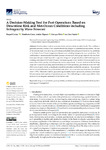A decision-making tool for port operations based on downtime risk and met-ocean conditions including infragravity wave forecast

Use this link to cite
http://hdl.handle.net/2183/32947Collections
- Investigación (ETSECCP) [826]
Metadata
Show full item recordTitle
A decision-making tool for port operations based on downtime risk and met-ocean conditions including infragravity wave forecastAuthor(s)
Date
2023Citation
Costas, R.; Carro, H.; Figuero, A.; Peña, E.; Sande, J. A Decision-Making Tool for Port Operations Based on Downtime Risk and Met-Ocean Conditions including Infragravity Wave Forecast. J. Mar. Sci. Eng. 2023, 11, 536. https://doi.org/10.3390/jmse11030536
Abstract
[Abstract:] Port downtime leads to economic losses and reductions in safety levels. This problem is generally assessed in terms of uni-variable thresholds, despite its multidimensional nature. The aim of the present study is to develop a downtime probability forecasting tool, based on real problems at the Outer Port of Punta Langosteira (Spain), and including infragravity wave prediction. The combination of measurements from three pressure sensors and a tide gauge, together with machine-learning techniques, made it possible to generate long wave prognostication at different frequencies. A fitting correlation of 0.95 and 0.9 and a root mean squared error (RMSE) of 0.022 m and 0.012 m were achieved for gravity and infragravity waves, respectively. A wave hindcast in the berthing areas, met-ocean forecast data, and information on 15 real operational problems between 2017 and 2022, were all used to build a classification model for downtime probability estimation. The proposed use of this tool addresses the problems that arise when two consecutive sea states have thresholds above 3.97%. This is the limit for guaranteeing the safety of port operations and has a cost of just 0.6 unnecessary interruptions of operations per year. The methodology is easily exportable to other facilities for an adequate assessment of downtime risks.
Keywords
Long waves prediction
Port operability
Multidimensional operational threshold
Machine learning
Port management
Port operability
Multidimensional operational threshold
Machine learning
Port management
Editor version
Rights
Atribución 3.0 España






